This past Saturday, Roazhon Park saw Rennes host Brest in Ligue 1 action. This game saw two of Ligue 1’s Brittany-based teams go head to head in a Derby de la Bretagne. This derby game came just eight days after Rennes faced off against their most well-known Brittany rivals, Nantes. This game also came just four days after Rennes took on their primary Champions League qualification rivals, Lille.
Ultimately, Saturday’s Derby de la Bretagne failed to produce the excitement of Rennes’ recent 3-2 derby win versus Nantes. This game ended scoreless, as both sides played out a 0-0 draw. Third-placed Rennes now sit just one point above fourth-placed UEFA Champions League qualification challengers, Lille.
In this tactical analysis piece, we will analyse the tactics deployed by both of these teams in Saturday’s game. We will provide a tactical analysis of both teams’ respective pressing strategies, as well as analysis of how both teams forged chances in this game.
Lineups and formations
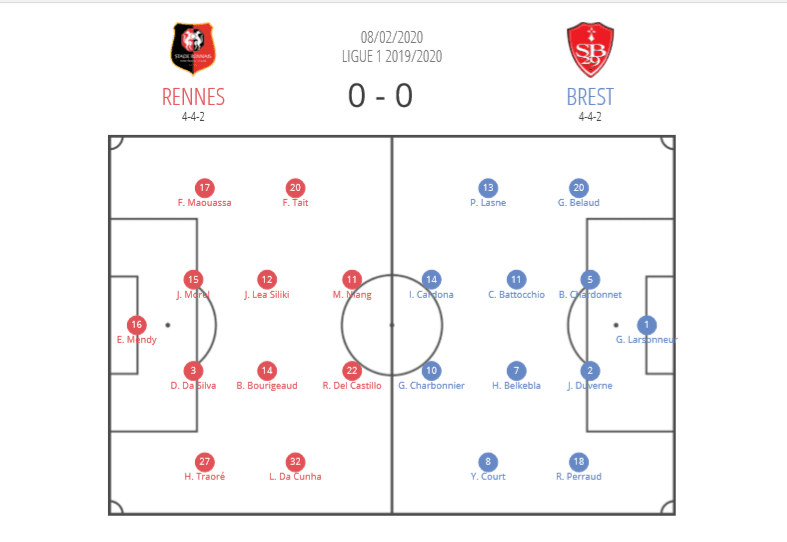
Rennes have lined up in a base 4-4-2 shape for the majority of their games this season. The home side once again lined up in a 4-4-2 shape for this past Saturday’s fixture. However, in-possession, Romain Del Castillo dropped slightly deeper than his strike partner M’Baye Niang. This allowed Del Castillo to influence play in between the lines, and add numbers to Rennes’ midfield area at times.
Rennes manager Julien Stéphan made a couple of notable changes to his regular midfield for this game. Two of Rennes’ most impressive players this season have been attacker Raphinha and midfield wunderkind Edouard Camavinga. However, both of them were absent for this past Saturday’s Derby de la Bretagne.
In Camavinga’s absence, versatile midfielder Benjamin Bourigeaud joined James Léa Siliki in central midfield. This allowed Flavien Tait and 18-year-old Lucas Da Cunha to occupy the wings for this game. This was Da Cunha’s first Ligue 1 start. Other than those two notable absentees, Rennes’ starting XI provided no surprises.
The visitors Brest similarly lined up in a 4-4-2 shape for Saturday’s game. Irvin Cardona joined Gaëtan Charbonnier in the centre-forward positions for this one. Brest were particularly weakened at the back for this game. They were without defenders Jean-Charles Castelletto, Julian Faussurier, and Dénys Bain for this game.
They were replaced by Gaëtan Belaud, Brendan Chardonnet, and Jean-Kévin Duverne. First-team regular left-back Romain Perraud joined them in Brest’s back four.
Rennes’ pressing tactics
Despite lining up in similar defensive shapes, these two teams pressed quite differently in Saturday’s game. The differences between the pressing tactics of these two sides had a large impact on how this game played out.
Brest didn’t retain much of the ball-possession during Saturday’s game. As the final whistle blew, they had accumulated just 42% of the possession, to Rennes’ 58%. Brest also struggled to build-up from the back throughout large portions of this fixture. This can be attributed to the way in which Rennes pressed them high up the pitch.
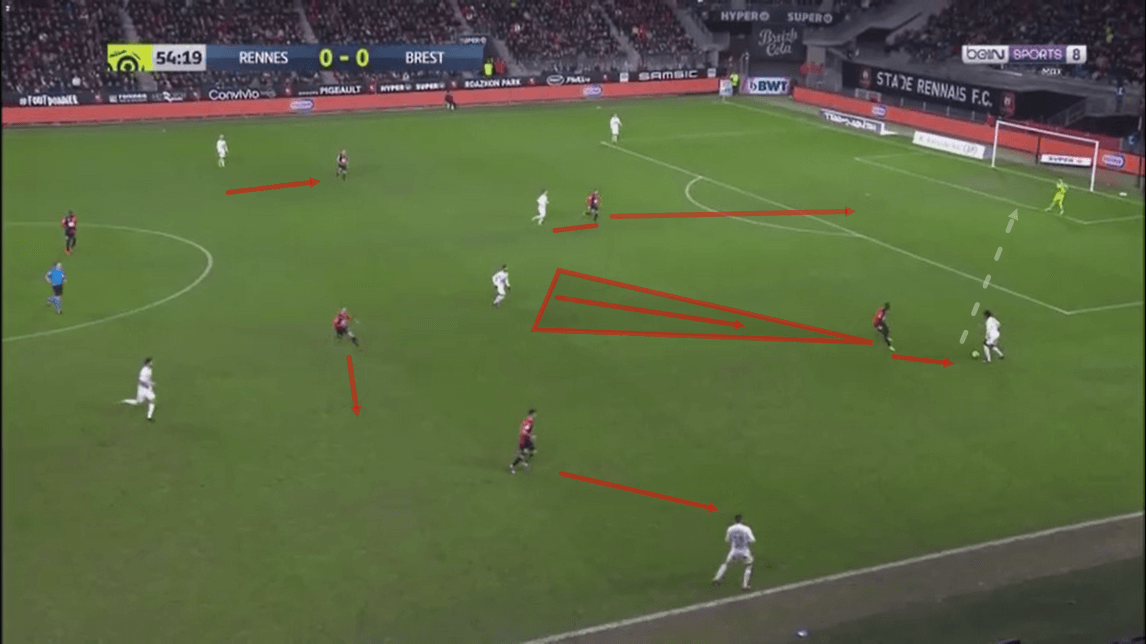
The image above provides us with an example of Rennes’ pressing tactics from Saturday’s game. Here we can see Brest’s left centre-back, Duverne in-possession of the ball as Brest attempt to build from the back. As Duverne receives possession, Rennes begin to deploy their press.
Firstly, we can see Del Castillo in the centre-forward position here. He is marking one of Brest’s centre-midfielders, Cristian Battocchio, as attempts to drop between the centre-backs. Battocchio’s movement makes him the nearest likely passing option to Del Castillo’s position in the 4-4-2. As a result, Del Castillo marks him, cutting off that passing option.
On the near wing, we see Da Cunha shifting over to mark left-back Perraud. We can also see Tait, on the opposite wing, readying himself to press Brest’s right centre-back Chardonnet, should Duverne play the ball back to the goalkeeper in an attempt to switch the play.
We can also see the near central midfielder Bourigeaud moving to cut off another progressive passing option. Meanwhile, Niang, as the nearest Rennes player to Duverne, presses the ball carrier. As Niang presses Duverne, he keeps Brest midfielder Haris Belkebla in his cover shadow. Doing this effectively ensures that Duverne can’t simply play around Niang’s press.
We can see that Rennes’ pressing tactics were quite man-oriented. Rennes didn’t man-mark any of Brest’s players during the build-up. However, they aggressively pressed the nearest opposition players to their position when they were passing options.
When they forced Brest to play the ball backwards, they generally continued to press them. In doing this, they hoped to force turnovers high up the pitch. Rennes played with quite a low tempo for the majority of this game. We will discuss this further later on in this tactical analysis piece.
However, The attacks where Rennes really created problems for Brest tended to come when Brest were making the transition to defence. Brest generally didn’t lose the ball with high numbers committed up the pitch in this game. Rennes forced the turnovers high up the pitch with their press to try and capitalise on Brest’s weakness in transition.
Alternatively, if they failed to force turnovers in the final third, Rennes often forced Brest to play inaccurate long balls. In doing so, they could still force turnovers and begin their own attack deep.
In addition to the advanced depth of their press, Rennes’ defensive shape was also quite wide. Their far-side defenders didn’t usually shift too far over as their side pressed. The wide positioning of Tait on the left-wing shows us somewhat of an example of this.
The defenders did this to ensure that they stayed tight to the far-side Brest attackers. This made it difficult for Brest to beat Rennes’ press by quickly switching play to the other wing.
Rennes’ defensive shape allowed Brest large pockets of space in-possession between the lines, near the ball carrier. However, they usually failed to capitalise on this weakness in Rennes’ defensive shape. Instead, they often succumbed to Rennes’ pressure, losing the ball.
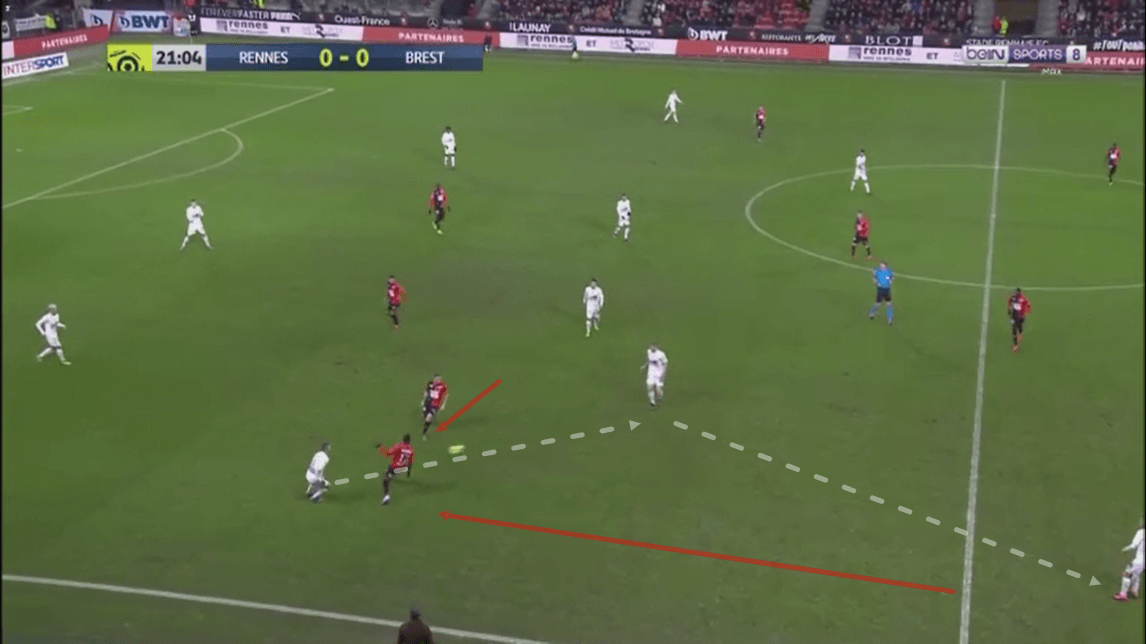
This image above shows us an example of one of the few occasions where Brest did exploit the space allowed to them between the lines as a result of Rennes’ press. As we can see here, Brest’s right-winger, Paul Lasne, drops deep to help his side in the build-up. As he drops, he is followed by Rennes left-back Faitout Maouassa.
Maouassa joins Tait in Rennes’ press, on the left-wing. However, The direction that both Maouassa and Tait are pressing from allows Lasne to play a pass between both defenders to pick out Battocchio in the midfield. Battocchio subsequently plays the ball out to Cardona, who we can see positioned on the right-wing. Brest are then able to start a dangerous counter-attack.
Brest also beat Rennes’ press and put their defence in trouble with the long-ball on a couple of occasions. However, Brest’s successful attempts at breaking Rennes’ press were few and far between. Ultimately, they generally struggled during the build-up in Saturday’s fixture. This shows us how Rennes’ defensive tactics were effective in preventing Brest from opening them up.
Brest’s pressing tactics
Brest’s pressing tactics differed significantly to Rennes’ pressing tactics this past Saturday. While Rennes defended in quite a wide shape, Brest defended in a much more narrow, compact shape. Furthermore, Brest’s line of engagement was significantly deeper than Rennes’ in this game. In addition to that, Brest defended against the ball carrier much more passively than Rennes.
The difference in the two sides defensive set-ups resulted in the two teams’ 4-4-2 systems looking and working drastically different to one another, in practice.
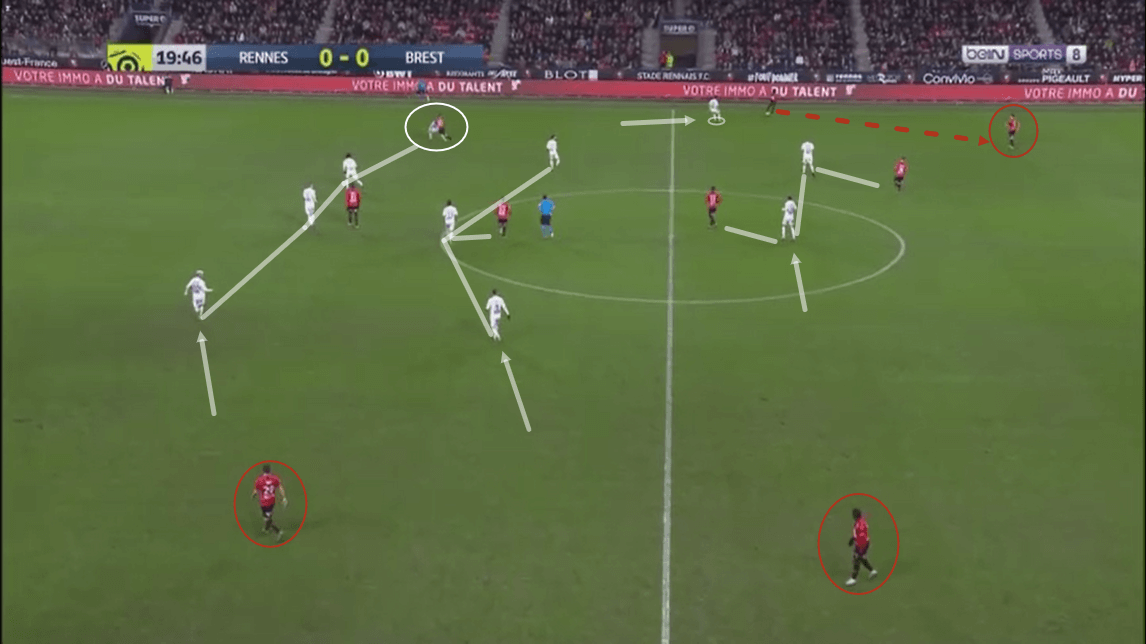
The image above shows us an example of Brest’s typical defensive set-up from Saturday’s game. Firstly, the difference in width between Brest’s shape here and Rennes’ in the previous images is clear to see. It is evident that Brest’s defensive shape is much more narrow and compact than Rennes’.
While Rennes allowed Brest more space between the lines, Brest allowed Rennes more space on the opposite wing. As Rennes move possession to the right-wing, Brest’s defensive shape presses in that direction. This creates a large amount of space between Brest’s right-sided players and Rennes’ left-sided players. However, these defensive tactics prevent Rennes from easily playing through them.
Brest generally didn’t press Rennes’ ball carrier aggressively throughout this game. In this image, we can see Yoann Court in close proximity to right-back Hamari Traoré, in-possession. However, Court is holding his ground and even backing off Troaré at this point. His primary focus is on preventing Traoré from progressing the ball, not forcing a turnover from him.
We can also see Brest left-back Perraud tightly marking the right-wing passing option of Del Castillo here. As centre-midfielder Bourigeaud drops deep, Brest centre-forward Charbonnier sticks to him. Meanwhile, Cardona also drops onto Rennes’ other centre-midfielder Léa Siliki.
Brest’s pressing tactics were not particularly aggressive. They didn’t usually attempt to directly force turnovers from the opposition. Instead, their goal in the press was to mark all of Rennes’ near passing options. In defence, their players were diligent about looking for short-passing options near to the ball carrier.
When they found potential passing options, if they were the closest player, they would mark that option and if another player was closer who hadn’t spotted the option, they could often be seen pointing out the potential danger to their teammate to close it down.
This allowed Rennes to essentially retain their tight compact shape while limiting Rennes’ short-passing options. As occurred in the passage of play seen above, this often forced Rennes to play the ball backwards. When this happened, Rennes would often attempt to switch the ball across the defence quickly to beat Brest’s compact shape.
On occasion, Rennes quick switches of play worked. However, Brest’s shape was generally compact and tough to play through. Even on occasions when they did eventually break into the midfield, Rennes were often quickly dispossessed at that point. This shows us how Brest prevented Rennes from playing through them in this game.
The important role of Rennes’ defence in the build-up
As we briefly discussed above, Brest’s press would often force Rennes to play passes back to the centre-backs. Brest were generally happy to allow Rennes’ defence to have the ball throughout this game. Brest usually didn’t press Rennes’ centre-backs at all. Instead, they retained their compact shape, while the two centre-forwards blocked the passing lane from Rennes’ centre-backs to the centre-midfielders.
Brest’s passive defensive tactics, along with Rennes’ slow tempo in-possession contributed largely to Rennes’ dominant possession statistics. However, Brest’s compact shape made it difficult for Rennes to turn their possession into clear-cut chances. As a result, they managed to hit the target with just three of their 18 goal attempts.
Brest’s defensive tactics made it difficult for Rennes to play through the midfield. However, the passive pressing of Rennes’ centre-backs allowed them to enjoy a lot of creative freedom.
Rennes’ centre-backs Damien Da Silva and Jérémy Morel became the sides’ primary creative sources for large portions of this game. The two centre-backs played a combined total of 19 accurate passes into the final third in Saturday’s game. This accounts for over a third of Rennes’ passes into the final third in this game. The two centre-backs played more passes into the final third than any other Rennes players.
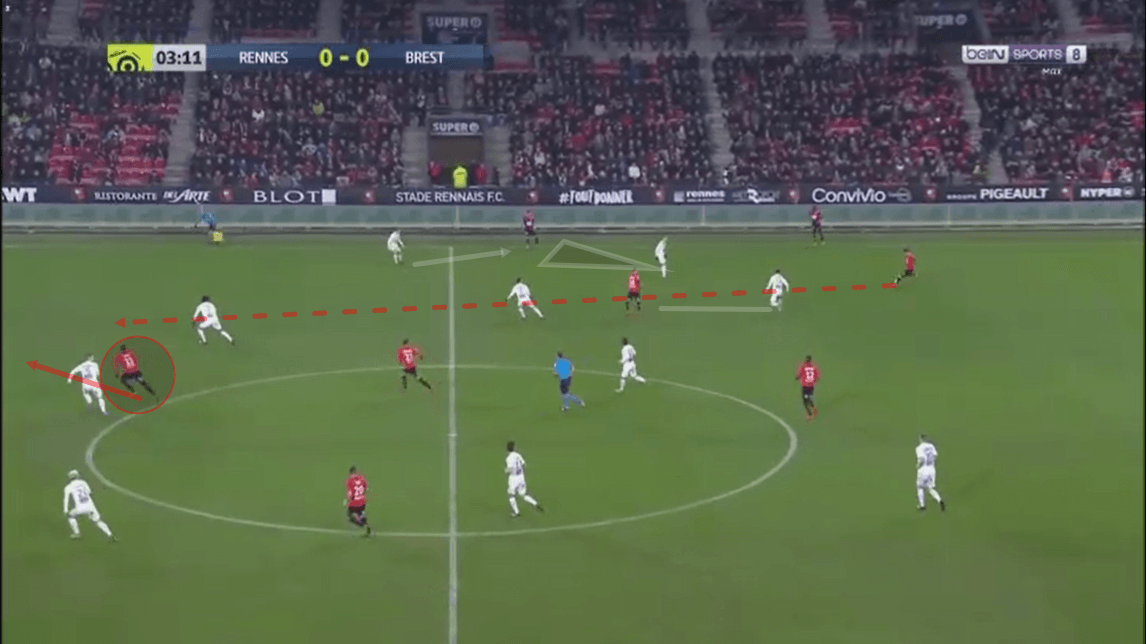
This image above shows us an example of Da Silva’s playmaking activity in action. As we can see in this image, Brest are set up in their narrow defensive shape here. They are closely marking Rennes progressive short-passing options. However, they are happy to allow Da Silva plenty of time on the ball.
On this occasion, Da Silva puts this time to use as he picks out Niang’s run in behind Brest’s defence. As this passage of play continues, Niang gets onto the end of Da Silva’s well-weighted long-ball. He subsequently manages to hold the ball up in Brest’s box and forges a decent goalscoring chance for himself.
This shows us just one example of the important creative role that Rennes’ centre-backs played in this game. Rennes’ centre-backs enjoyed time on the ball throughout this game to pick out long-balls. They were a pivotal source of creativity for Rennes in this game.
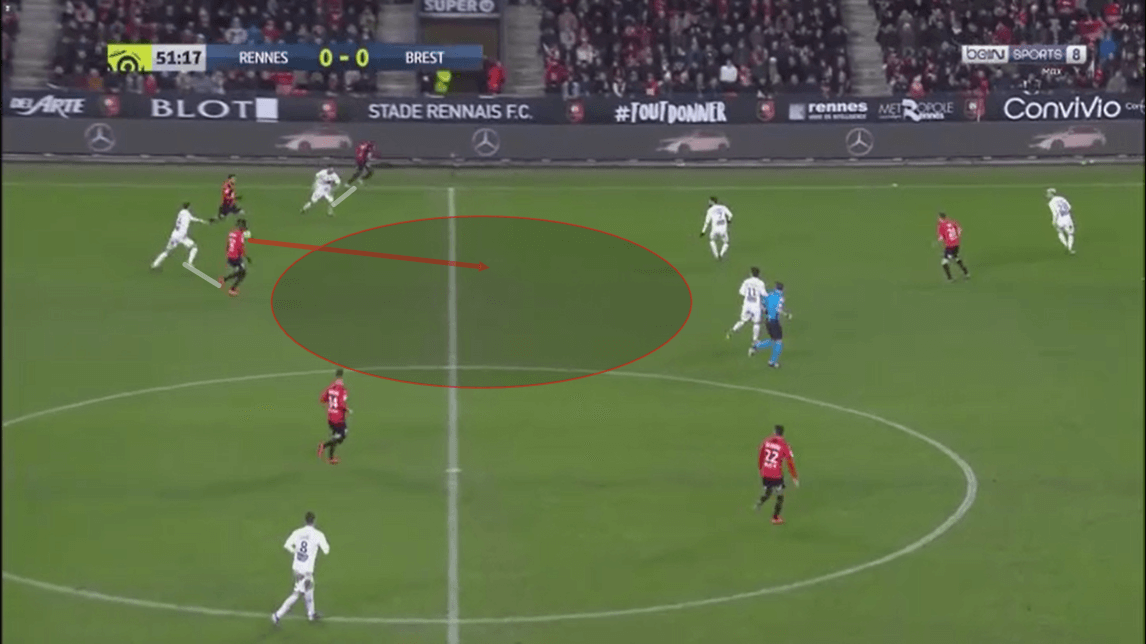
This next image shows us another example of how Rennes’ defence influenced their creativity in this game. Brest tended not to aggressively press the Rennes ball carrier until they made their way into Rennes’ half. This, in addition to Brest’s passive treatment of Rennes’ centre-backs, allowed Morel and Da Silva to carry the ball past Brest’s press themselves at times in this game.
The image above shows us an example of Morel, in the process of dribbling past Brest’s first line of defence. Brest’s right-winger can be seen positioning himself between Morel and left-back Maouassa. Meanwhile, we can see Cardona positioned on the opposite side of Morel, covering the pass to Léa Siliki.
While both Brest players cut off potential passing lanes for Morel, they leave a gap for Morel to simply carry the ball upfield. As Morel progresses past the first line of Brest’s press, he carries the ball into centre-midfield. He subsequently attempts to play a quick passing combination with Tait and Del Castillo. Both can be seen in advanced positions in the image above.
However, Brest’s deeper defensive lines remained solid and compact. They ultimately pounced on Morel’s attempt to combine with Tait and Del Castillo, shutting down the Rennes attack.
In addition to playing long-balls, Rennes’ defence often made use of their ball-carrying ability in this game. As Brest tended not to aggressively press the ball carrier, this allowed Rennes to beat Brest’s first line of defence by dribbling past them into the midfield. Despite their effectiveness at beating Brest’s press, Rennes struggled to break down Brest’s solid backline throughout this game.
Del Castillo’s free role in the final third
Another important element to Rennes’ offensive play was the important role of Del Castillo in Rennes’ attack. As we touched on at the beginning of this tactical analysis, Del Castillo played behind Niang, in-possession. Del Castillo generally occupied a free role operating between the lines in the final third. He was a constant creative threat in this role.
Del Castillo’s versatility was crucial to Rennes’ attempts at breaking down Brest in this game. He occupied the centre-forward position, the wide-forward positions, and the centre-midfield position during the course of this game. Del Castillo’s free role combined with his versatility to make him an important asset in various phases of Brest’s play.
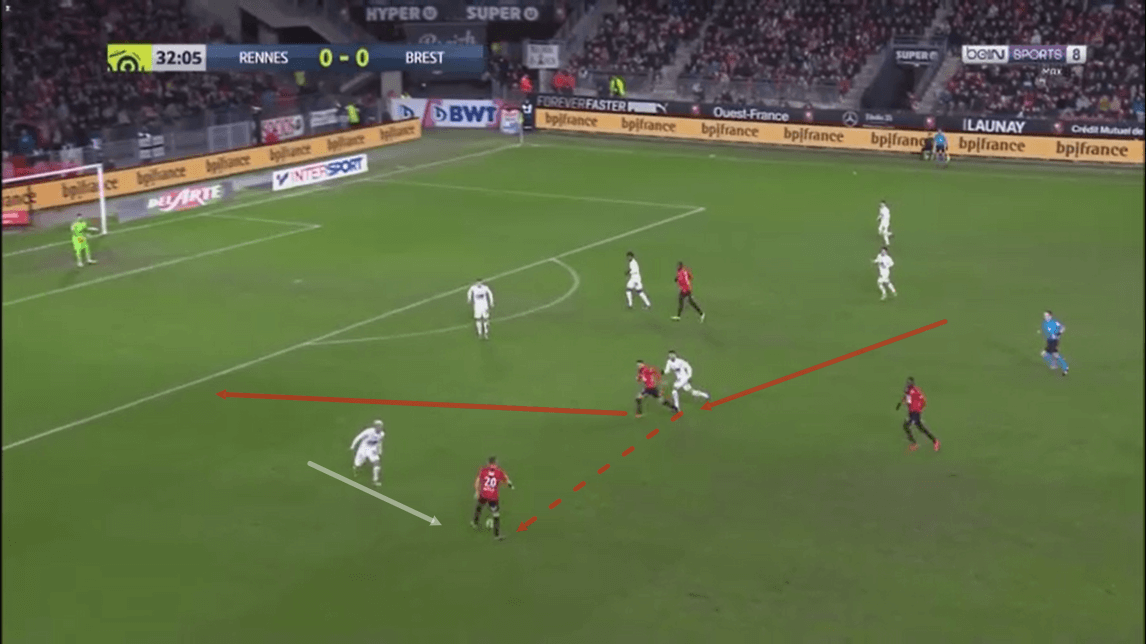
The image above shows us an example of the importance of Del Castillo’s movement and playmaking in the final third. Just prior to this image, Del Castillo received the ball in a deeper position. He was also positioned more to the right side of the pitch upon receiving the ball.
As play moved, he carried the ball towards the left-wing and played it to Tait, as we see here. Del Castillo’s pass to Tait forced Brest right-back Belaud to close down the left-winger. As he did so, this created a large gap in Brest’s defence.
As this passage of play moves on, Del Castillo subsequently continues his run in behind Belaud. Tait manages to pick out Del Castillo’s run in behind Brest’s defence.
This attack ultimately fizzles out, however, it shows us the importance of Del Castillo’s free role in the final third. Del Castillo was given the freedom to roam around the final third. In this particular passage of play, he moves from a deep position on the right, through the centre, and into an advanced position on the left. This shows us the importance of his free role and how he put it to use.
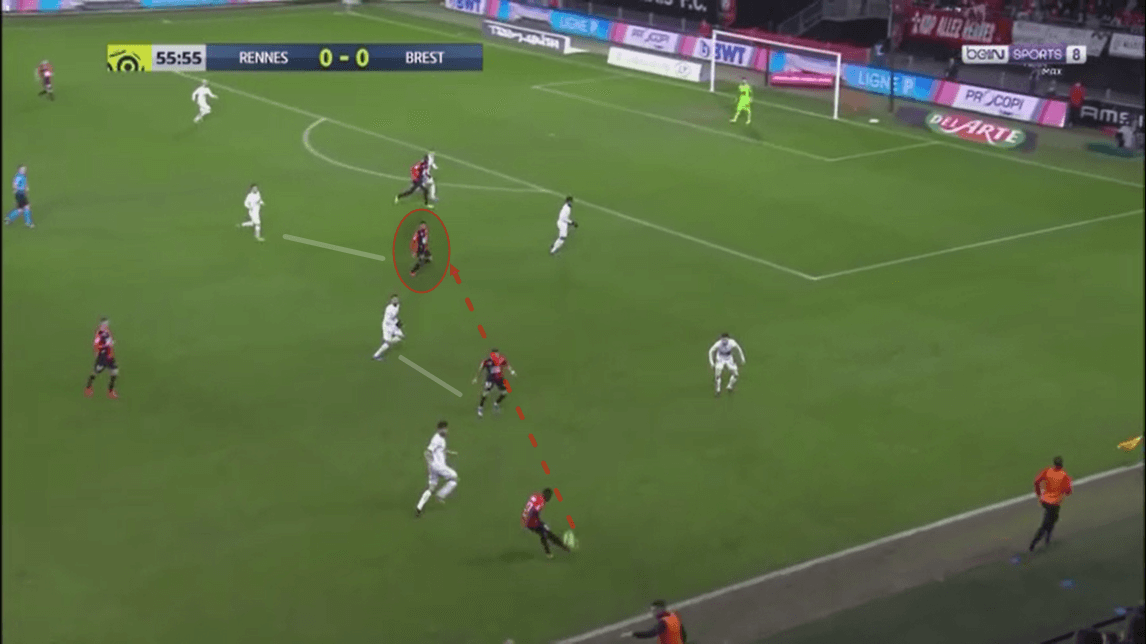
This next image shows us an example of how Del Castillo’s movement created issues for Brest between the lines. Here, we can see Del Castillo drifting into the right half-space. He manages to occupy a tight pocket of space between Brest’s compact midfield and defensive lines. Del Castillo’s run ultimately isn’t picked up here, as Brest prioritise holding their shape.
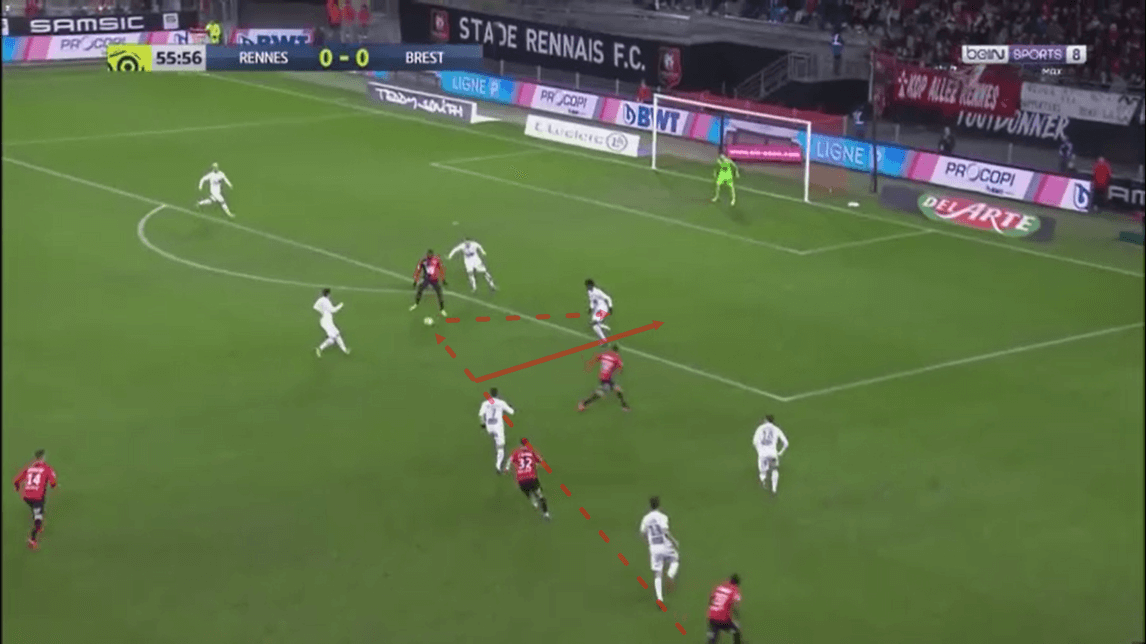
This second image shows us how Del Castillo’s movement and creativity hurt Brest as play moves on. Ball carrier Traoré plays the ball from the right-wing into Del Castillo in the right half-space. However, the unmarked attacker dummies the ball, allowing it to run through to Niang.
As this image shows, following his dummy, Del Castillo begins to run in behind Brest’s backline. His run and dummy to Niang sets up a dangerous Rennes attack for Brest to deal with. However, Niang’s final ball ultimately failed to beat Duverne, who makes a crucial last-ditch interception.
Both of these attacks failed to create a clear-cut chance. However, both of them show us the importance of Del Castillo’s playmaking ability in Rennes’ attacking play in this game. Del Castillo, along with Rennes’ centre-backs provided a much needed creative spark to this game. Had Del Castillo been found more often, Rennes may have found a breakthrough here.
Conclusion
To conclude this tactical analysis piece, it is clear that Rennes and Brest both set up well to effectively deny the other team many goalscoring opportunities. Rennes’ more aggressive pressing tactics effectively prevented Brest from building many chances from the back. While Brest managed to beat their press on occasion, it wasn’t enough to break them down.
Similarly, Brest’s more passive pressing tactics also worked for them to deny Rennes much joy playing through them. Rennes struggled to build past Brest’s defensive shape for large portions of this game. When they did manage to start beating Brest’s press more consistently, they still struggled to play through their backline. Both of these teams ultimately provided puzzles too difficult for the other team to solve in this game.


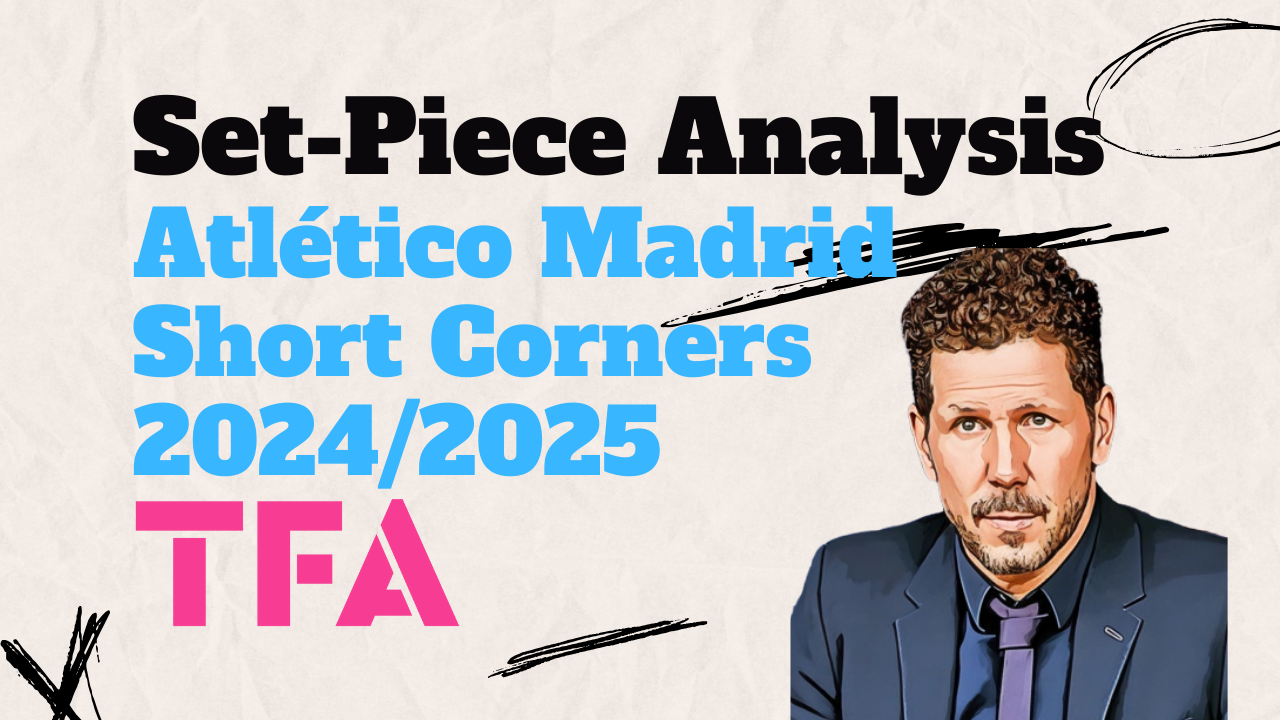
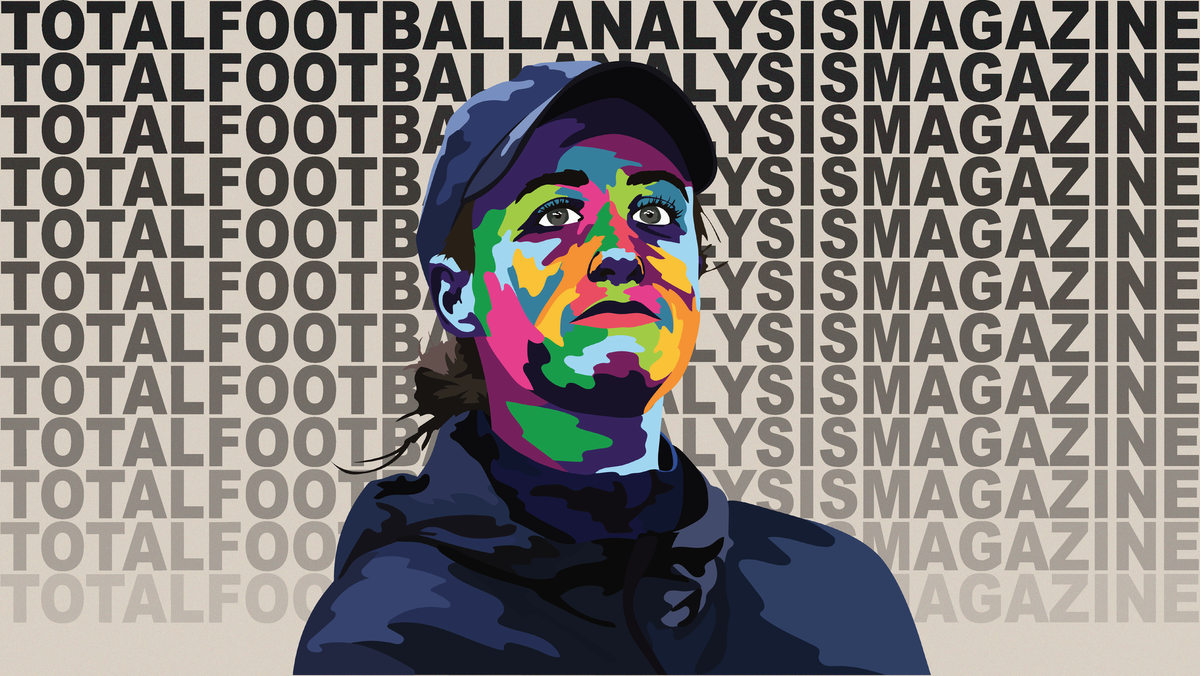
Comments